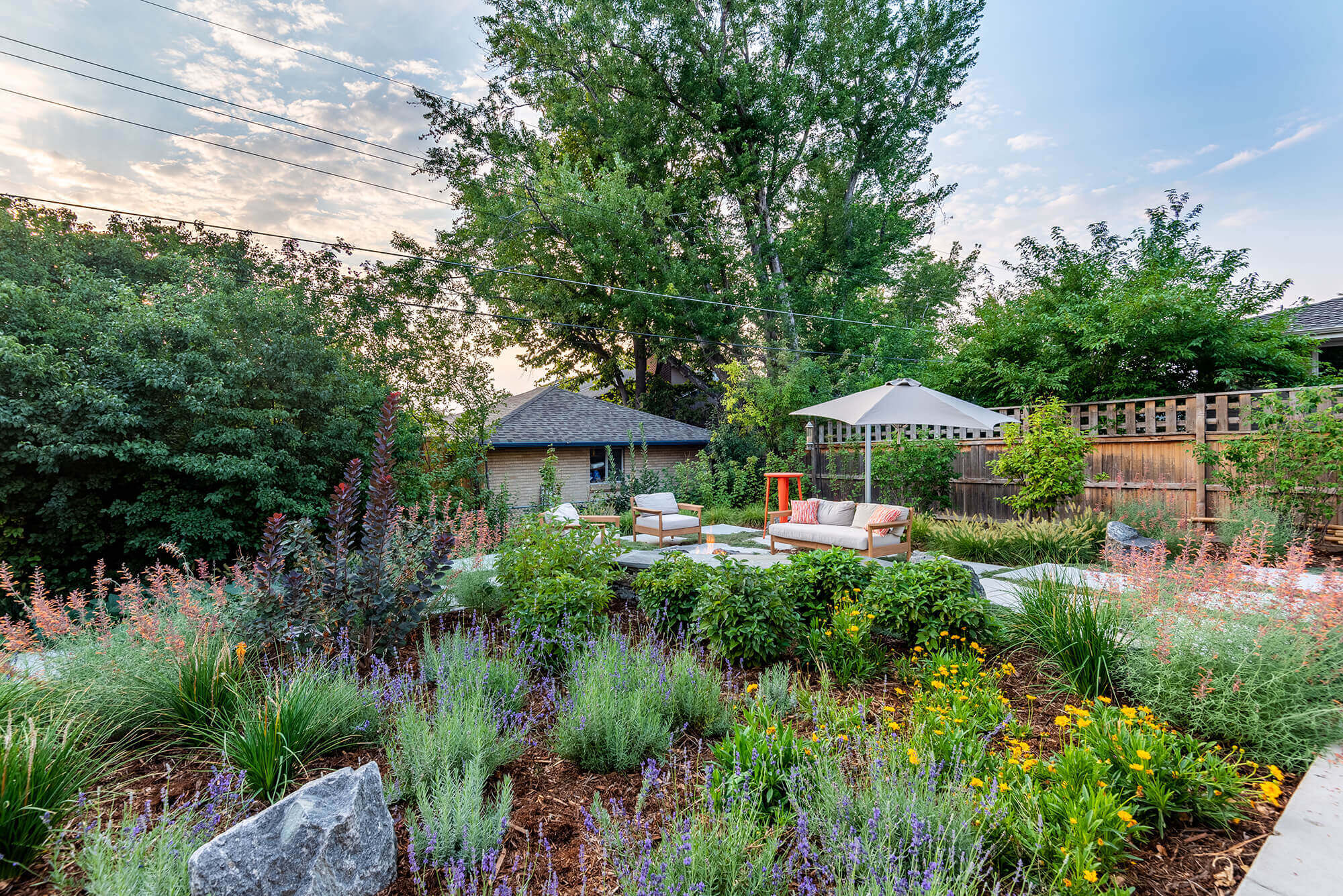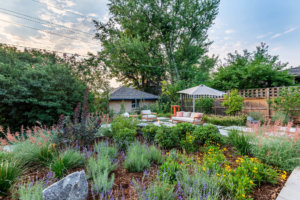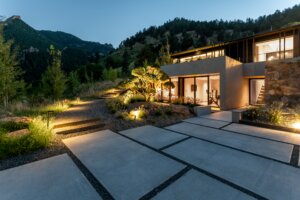
The Benefits of Xeriscaping in Colorado: Water-Saving Landscapes That Don’t Compromise on Style
Colorado’s stunning natural landscapes are a major draw for residents, but the state’s arid climate and frequent droughts pose unique challenges for maintaining traditional lawns and gardens. As water becomes an increasingly precious resource, homeowners are seeking ways to reduce their water usage without sacrificing the beauty and functionality of their outdoor spaces. Xeriscaping, a landscaping philosophy that focuses on water conservation, has emerged as a popular and effective solution. At Environmental Designs, we believe that xeriscaping offers an innovative approach to creating water-saving landscapes that don’t compromise on style. In this blog, we’ll explore the benefits of xeriscaping in Colorado, highlight lawn alternatives to grass, and showcase how evergreen plants can add year-round interest to your landscape.
Understanding Xeriscaping
Xeriscaping is derived from the Greek word “xeros,” meaning dry, and it refers to landscaping techniques that minimize the need for supplemental irrigation. This approach is particularly well-suited to Colorado, where the high altitude and arid conditions can make traditional lawns and gardens difficult and expensive to maintain. Xeriscaping involves selecting drought-tolerant plants, optimizing irrigation systems, and designing landscapes that require minimal water while still being visually appealing.
The Benefits of Xeriscaping in Colorado
Xeriscaping offers numerous benefits for homeowners in Colorado, ranging from water conservation to reduced maintenance costs. Let’s take a closer look at some of the key advantages:
- Significant Water Savings: One of the most compelling reasons to adopt xeriscaping is its potential for water conservation. Traditional lawns require significant amounts of water to stay green and healthy, especially during Colorado’s hot, dry summers. Xeriscaped landscapes, on the other hand, are designed to thrive with minimal irrigation. By using drought-tolerant plants and efficient irrigation systems, homeowners can reduce their outdoor water usage by up to 60% or more. This not only helps to conserve a precious natural resource but also results in lower water bills.
- Lower Maintenance Requirements: Xeriscaping is also an excellent choice for homeowners who want a beautiful landscape without the hassle of constant upkeep. Traditional lawns require regular mowing, fertilizing, and watering, which can be time-consuming and costly. In contrast, xeriscaped landscapes are designed to be low-maintenance. Drought-tolerant plants typically require less water and fertilizer, and many are resistant to pests and diseases. Additionally, xeriscaping often involves the use of mulch, which helps to suppress weeds and retain soil moisture, further reducing the need for maintenance.
- Enhanced Curb Appeal: Contrary to the misconception that xeriscaping means a barren, rocky yard, xeriscaped landscapes can be incredibly beautiful and diverse. By carefully selecting a variety of plants, homeowners can create visually stunning landscapes that enhance their property’s curb appeal. Xeriscaping offers the opportunity to incorporate a wide range of colors, textures, and forms into your landscape design. Whether you prefer the vibrant blooms of drought-tolerant perennials or the sculptural beauty of evergreen shrubs, xeriscaping allows you to create a unique and attractive outdoor space.
- Environmental Benefits: Xeriscaping is not only beneficial for homeowners but also for the environment. By reducing water usage, xeriscaped landscapes help to alleviate the strain on local water supplies, particularly during times of drought. Additionally, many xeriscape plants are native to Colorado, meaning they are well-adapted to the local climate and require fewer resources to thrive. Native plants also provide habitat and food for local wildlife, such as birds, bees, and butterflies, contributing to the overall health of the ecosystem. Furthermore, xeriscaping reduces the need for chemical fertilizers and pesticides, which can have harmful effects on the environment.
Lawn Alternatives to Grass
For many homeowners, the idea of replacing a traditional lawn with something more sustainable can be daunting. However, there are numerous attractive and functional alternatives to grass that can be incorporated into a xeriscaped landscape. Here are some popular lawn alternatives that work well in Colorado’s climate:
- Groundcovers: Groundcovers are low-growing plants that spread to form a dense mat, effectively covering the ground and providing a lush, green alternative to grass. Many groundcovers are drought-tolerant and require minimal maintenance, making them ideal for xeriscaping. Some popular groundcovers for Colorado include:
- Creeping Thyme (Thymus serpyllum): This fragrant herb forms a dense carpet of small, green leaves and produces tiny purple flowers in the summer. Creeping thyme is drought-tolerant, requires little water, and is perfect for sunny areas.
- Blue Fescue (Festuca glauca): This ornamental grass has fine, blue-gray foliage that adds texture and color to the landscape. Blue fescue is drought-tolerant and thrives in well-drained soil.
- Sedum (Sedum spp.): Sedums are succulent plants that store water in their leaves, making them exceptionally drought-tolerant. They come in a variety of colors and forms, from low-growing mats to upright varieties with showy flowers.
- Gravel and Mulch: Gravel and mulch are practical and attractive alternatives to grass that require no water or maintenance. Gravel can be used to create pathways, patios, and decorative areas, while mulch helps to retain soil moisture and suppress weeds. Both materials come in a variety of colors and textures, allowing for creative design possibilities.
- Artificial Turf: For homeowners who want the look of a traditional lawn without the water usage and maintenance, artificial turf is an excellent option. Modern artificial turf has come a long way in terms of appearance and feel, closely resembling natural grass. It’s durable, low-maintenance, and can be used in areas where grass is difficult to grow.

Incorporating Evergreen Plants
Evergreen plants are a key component of xeriscaping, providing year-round interest and structure to the landscape. Unlike deciduous plants, which lose their leaves in the fall, evergreens retain their foliage throughout the year, offering consistent color and texture. In Colorado’s climate, where winters can be long and harsh, evergreen plants are especially valuable for maintaining visual appeal during the colder months.
- Junipers (Juniperus spp.): Junipers are hardy, drought-tolerant evergreens that come in a variety of shapes and sizes, from low-growing groundcovers to tall, upright shrubs. Their needle-like foliage ranges in color from deep green to blue-gray, and some varieties even produce small, decorative berries. Junipers are well-suited to Colorado’s climate and require minimal water once established.
- Pine Trees (Pinus spp.) Pine trees are another excellent choice for xeriscaping in Colorado. These evergreens are drought-tolerant and can thrive in a variety of soil types. They provide shade, windbreaks, and habitat for wildlife, making them a valuable addition to any landscape. Some popular species for Colorado include Ponderosa Pine (Pinus ponderosa) and Austrian Pine (Pinus nigra).
- Yuccas (Yucca spp.) Yuccas are striking evergreen plants that add a bold, architectural element to xeriscaped landscapes. With their spiky leaves and tall flower spikes, yuccas are drought-tolerant and require little maintenance. They thrive in well-drained soil and full sun, making them ideal for Colorado’s arid conditions.
Designing Your Xeriscape
Designing a xeriscape requires thoughtful planning and consideration of the unique conditions of your property. At Environmental Designs, we work closely with homeowners to create customized xeriscape plans that meet their aesthetic preferences and water conservation goals. Here are some tips for designing a successful xeriscape:
- Assess Your Site: Start by assessing your property’s existing conditions, including soil type, sun exposure, and drainage patterns. This will help you choose the right plants and design elements for your xeriscape.
- Group Plants by Water Needs: To maximize water efficiency, group plants with similar water needs together. This allows you to tailor your irrigation system to deliver the right amount of water to each area of your landscape.
- Incorporate Hardscaping: Hardscaping elements, such as patios, walkways, and retaining walls, can add structure and visual interest to your xeriscape while reducing the amount of water needed for plantings. Use materials like gravel, stone, and pavers to create functional and attractive outdoor spaces.
- Use Mulch: Mulch is an essential component of xeriscaping, helping to retain soil moisture, suppress weeds, and regulate soil temperature. Organic mulches, such as wood chips or bark, are particularly effective in xeriscapes.
Next Steps
Xeriscaping offers Colorado homeowners a sustainable and stylish way to create beautiful landscapes that thrive in the state’s challenging climate. By choosing drought-tolerant plants, exploring lawn alternatives to grass, and incorporating evergreen plants, you can design a landscape that conserves water, reduces maintenance, and enhances your property’s curb appeal. At Environmental Designs, we are passionate about helping our clients achieve their landscaping goals while promoting environmental stewardship. Whether you’re starting from scratch or looking to convert your existing lawn to a xeriscape, our team of experts is here to guide you every step of the way.


